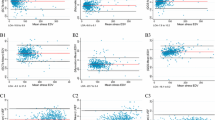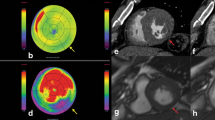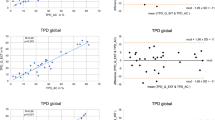Abstract
The aim of this study was to assess global left ventricular (LV) function and regional wall motion using retrospectively ECG-gated 16-slice computed tomography (CT) in comparison with magnetic resonance imaging (MRI). Twenty-one patients (18 male, 65.5±8.6 years) with acute myocardial infarction underwent multislice spiral CT (MSCT) and MRI. From manually drawn endo- and epicardial contours, LV volumes including myocardial mass, peak filling rate (PFR), peak ejection rate (PER), time to PER (TPER) and time from end-systole to PFR (TPFR) were calculated. Regional wall motion was assessed from cine loops using a 16-segment model of the left ventricle. LV function was analyzed using the Bland–Altman method, Pearson’s correlation coefficient, multivariate analysis and post hoc t tests. Regional wall motion was evaluated with weighted kappa-statistics. Multivariate analysis revealed significant differences for global LV function as determined by MSCT and MRI. Post hoc t-tests showed significant differences for end-diastolic volume (EDV), PFR and TPER (P<0.05), while there was a good agreement for the LV volumes with an ejection fraction of 46.9±8.4% for MSCT and 46.9±8.9% for MRI. PER, PFR, TPER and TPFR presented a poor correlation and a wide range of scattering between MSCT and MRI. Regional wall motion scores showed a good agreement with κ=0.791. Sixteen-slice spiral CT allows for reliable assessment of LV volumes, but is not yet suited for the evaluation of all functional parameters. Assessment of regional wall motion at rest is feasible.



Similar content being viewed by others
References
Ropers D, Baum U, Pohle K, Anders K, Ulzheimer S, Ohnesorge B, Schlundt C, Bautz W, Daniel WG, Achenbach S (2003) Detection of coronary artery stenoses with thin-slice multi-detector row spiral computed tomography and multiplanar reconstruction. Circulation 107:664–666
Nieman K, Cademartiri F, Lemos PA, Raaijmakers R, Pattynama PMT, de Feyter PJ (2002) Reliable noninvasive coronary angiography with fast submillimeter multislice spiral computed tomography. Circulation 106:2051–2054
Juergens KU, Grude M, Fallenberg EM, Opitz C, Wichter T, Heindel W, Fischbach R (2002) Using ECG-gated multidetector CT to evaluate global left ventricular myocardial function in patients with coronary artery disease. Am J Roentgenol 179:1545–1550
Mahnken AH, Spüntrup E, Wildberger JE, Heuschmid M, Niethammer M, Sinha AM, Flohr T, Bücker A, Günther RW (2003) Quantification of cardiac function with multislice CT using retrospective EKG-gating: comparison with MRI. Fortschr Geg Rontgenstr 175:83–88 (German)
Flohr T, Ohnesorge B (2001) Heart rate adaptive optimization of spatial and temporal resolution for electrocardiogram-gated multislice spiral CT of the heart. J Comput Assist Tomogr 25:907–923
Dirksen MS, Bax JJ, de Roos A, Jukema JW, van der Geest RJ, Geleijns K, Boersma E, van der Wall EE, Lamb HJ (2002) Usefulness of dynamic multislice computed tomography of left ventricular function in unstable angina pectoris and comparison with echocardiography. Am J Cardiol 90:1157–1160
Juergens KU, Grude M, Maintz D, Fallenberg EM, Wichter T, Heindel W, Fischbach R (2004) Multi-detector row CT of left ventricular function with dedicated analysis software versus MR imaging: initial experience. Radiology 230:403–410
Mahnken AH, E. Spuentrup, Niethammer M, Buecker A, Boese J, Wildberger JE, Flohr T, Sinha AM, Krombach GA, Gunther RW (2003) Quantitative and qualitative assessment of left ventricular volume with ECG-gated multislice spiral CT: value of different image reconstruction algorithms in comparison to MRI. Acta Radiol 44:604–611
Flohr T, Bruder H, Stierstorfer K, Simon J, Schaller S, Ohnesorger B (2002) New technical developments in multislice CT, part 2: sub-millimeter 16-slice scanning and increased gantry rotation speed for cardiac imaging. Rofo Fortschr Geb Rontgenstrahlen Neuen Bildgeb Verfahr 174:1022–1027
Thompson BH, Stanford W (1994) Evaluation of cardiac function with ultrafast computed tomography. Radiol Clin N Am 32:537–551
Cerqueira MD, Weissman NJ, Dilsizian V, Jacobs AK, Kaul S, Laskey WK, Pennell DJ, Rumberger JA, Ryan T, Verani MS (2002) Standardized myocardial segmentation and nomenclature for tomographic imaging of the heart: a statement for healthcare professionals from the Cardiac Imaging Committee of the Council on Clinical Cardiology of the American Heart Association. Circulation 105:539–542
Kalender WA, Schmidt B, Zankl M, Schmidt M (1999) A PC program for estimating organ dose and effective dose values in computed tomography. Eur Radiol 9:552–562
Landis J, Koch GG (1977) The measurement of observer agreement for categorical data. Biometrics 33:159–174
Emond M, Mock MB, Davis KB, Fisher LD, Holmes DR Jr, Chaitman BR, Kaiser GC, Alderman E, Killip T III (1994) Long-term survival of medically treated patients in the Coronary Artery Surgery Study (CASS) Registry. Circulation 90:2645–2657
Hofmann T, Meinertz T, Kasper W, Geibel A, Zehender M, Hohnloser S, Stienen U, Treese N, Just H (1988) Mode of death in idiopathic dilated cardiomyopathy: a multivariate analysis of prognostic determinants. Am Heart J 116:1455–1463
White HD, Norris RM, Brown MA et al (1987) Left ventricular end-systolic volume as the major determinant of survival after recovery from myocardial infarction. Circulation 76:44–51
Soldo SJ, Norris SL, Gober JR Haywood LJ, Colletti PM, Terk M (1994) MRI-derived ventricular volume curves for the assessment of left ventricular function. Magn Reson Imaging 12:711–717
Lieberman AN, Weiss JL, Jugdutt BI et al (1981) Two-dimensional echocardiography and infarct size: relationship of regional wall motion and wall thickening to the extent of myocardial infarction in the dog. Circulation 63:739–746
Greenberg SB, Sandhu SK (1999) Ventricular function. Radiol Clin N Am 37:341–359
Alfakih K, Reid S, Jones T, Sivananthan M (2004) Assessment of ventricular function and mass by cardiac magnetic resonance imaging. Eur Radiol 14:1813–1822
Rerkpattanapipat P, Mazur W, Link KM, Hundley WG (2003) Assessment of cardiac function with MR imaging. Magn Reson Imaging Clin N Am 11:67–80
Miller S, Simonetti OP, Carr J, Kramer U, Finn JP (2002) MR imaging of the heart with cine true fast imaging with steady-state precession: influence of spatial and temporal resolutions on left ventricular functional parameters. Radiology 223:263–269
Ritchie CJ, Godwin JD, Crawford CR et al (1992) Minimum scan speeds for suppression of motion artifacts in CT. Radiology 185:37–42
Kuijpers D, van Dijkman PR, Janssen CH, Vliegenthart R, Zijlstra F, Oudkerk M (2004) Dobutamine stress MRI. Part II. Risk stratification with dobutamine cardiovascular magnetic resonance in patients suspected of myocardial ischemia. Eur Radiol 14:2046–2052
Setser RM, Fischer SE, Lorenz CH (2000) Quantification of left ventricular function with magnetic resonance images acquired in real time. J Magn Reson Imaging 12:430–438
Mancini GB, Bloomquist JN, Bhargava V, Stein JB, Lew W, Slutsky RA, Shabetai R, Higgins CB (1983) Hemodynamic and electrocardiographic effects in man of a new nonionic contrast agent (Iohexol): advantages over standard ionic agents. Am J Cardiol 51:1218–1222
Bettmann MA, Higgins CB (1985) Comparison of an ionic with a nonionic contrast agent for cardiac angiography. Results of a multicenter trial. Invest Radiol 20:S70–S74
Boehm T, Alkadhi H, Roffi M, Willmann JK, Desbiolles LM, Marincek B, Wildermuth S (2004) Time-effectiveness, observer-dependence, and accuracy of measurements of left ventricular ejection fraction using 4-channel MDCT. Rofo Fortschr Geb Rontgenstrahlen Neuen Bildgeb Verfahr 176:529–537
Author information
Authors and Affiliations
Corresponding author
Rights and permissions
About this article
Cite this article
Mahnken, A.H., Koos, R., Katoh, M. et al. Sixteen-slice spiral CT versus MR imaging for the assessment of left ventricular function in acute myocardial infarction. Eur Radiol 15, 714–720 (2005). https://doi.org/10.1007/s00330-004-2592-x
Received:
Revised:
Accepted:
Published:
Issue Date:
DOI: https://doi.org/10.1007/s00330-004-2592-x




